 Image search results - "moat" Image search results - "moat" |

Bridge to castle grounds. 5-min. walk from Fukui Station.
|
|

Bridge to castle grounds with prefectural capital building looming ahead.
|
|
|

Statue of castle founder and 1st lord, Yuki Hideyasu 結城秀康
|
|

Valley between the prefectural capital (left) and police department (right).
|
|

Stone foundation of the castle tower at one corner.
|
|

Stairs to castle tower foundation
|
|

Atop the castle tower foundation (lower level)
|
|

Monuments
|
|

The castle tower suffered a major fire in 1669, and it was never rebuilt.
|
|

Steps to upper level of castle tower foundation
|
|
|

Top of castle tower foundation. Grassy, but uneven ground.
|
|

Another stone foundation which was partially damaged during the 1948 Fukui Easrthquake.
|
|
|

Steps to go down.
|
|

View of moat from the corner of castle tower foundation.
|
|

Stone wall submerged in moat.
|
|
|

The cherry blossoms lining Sotobori Moat also look stunning from the road, Sotobori-dori in front of Kagurazaka.
|
|

Castle tower foundation
|
|

People in a long line waiting to enter Canal Cafe to either dine or rent a rowboat.
|
|
|

Canal Cafe is right below the cherries. But notice empty tables despite the long line.
|
|

This is the castle well named Fuku-no-I (福の井). Fukui Prefecture got its name from this well. In 2017, it got a Japanese-style roof.
|
|

Empty rowboats too.
|
|
|
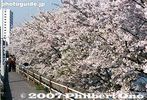
Cherry trees along the Sotobori Moat. Formerly a moat of Edo Castle, this canal stretching from Iidabashi Station to Ichigaya Station along the Chuo Line.
|
|
|
|
|
|
|
|
|

Rowboats and low-hanging cherries.
|
|

Another bridge 廊下橋
|
|

The end of the moat is also a good viewpoint.
|
|

Fukui police HQ and castle wall
|
|

The end of the moat is also a good viewpoint.
|
|
|

How it looks from the end of the moat.
|
|
|
|

How it looks from the end of the moat.
|
|

Pedestrian bridge
|
|
|
|
|

The moat is parallel to the Chuo Line. View from Shin-Mitsuke Bridge. 新見附橋
|
|
|

Sobu Line passes through.
|
|

Prefectural capital building
|
|

Sobu Line passes through.
|
|

Mismatched buildings
|
|

Chuo Line passes through. 中央線
|
|
|
|
|
|

Photographers who love trains and cherries flock here.
|
|
|
|
|

Canal Cafe
|
|

Sotobori Park on the other side of the moat. 外濠公園
|
|
|
|

Hachiman-bori is quite long and it even connects to Lake Biwa. The main part of moat is about 1 km long. I started walking here on the west end near the Omi-Hachiman Public Library. MAP
|
|
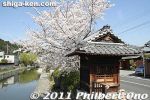
Hachiman-bori is also part of the National Important Traditional Townscape Preservation District (重要伝統的建造物群保存地区).
|
|
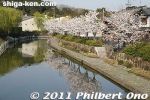
If the cherry blossoms are in bloom, I recommend walking along the canal from the west end since the sun will be on your back and on the flowers.
|
|
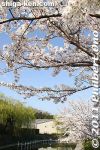
The cherry trees start from near the Omi-Hachiman Public Library. They continue all the way to the main torii of Himure Hachimangu Shrine.
|
|

Also during sakura season, the yakata-bune boats offer moat rides for 1,000 yen for adults. Boats leave from near The Kawara Roof Tile Museum on the east end of the moat.
|
|
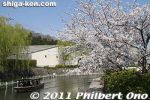
I was in Omi-Hachiman to see the Hachiman Matsuri fire festival on April 14. I was lucky to find the cherries in full bloom at Hachiman-bori moat on a sunny day.
|
|

Perfect day to shoot cherry blossoms.
|
|
|
|
|
|
|
|
|
|
|
|
|
|
|
|
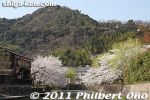
Mt. Hachiman-yama is in the background. An aerial tramway goes up the mountain which was the site of Hachiman Castle.
|
|
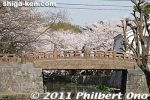
A few bridges also cross the moat. This is Meijibashi Bridge. 明治橋
|
|
|
|
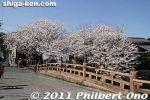
Bridge in Osugi-cho. 大杉町
|
|
|
|
|
|
|
|
|
|
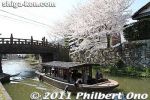
Yakata-bune tourist boat cruising through Hachiman-bori moat in Omi-Hachiman.
|
|
|
|
|
|
|
|
|
|
|
|
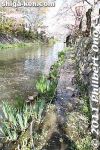
You can easily walk along the entire moat except for this section which is a little flooded. My waterproof shoes came in handy.
|
|
|
|
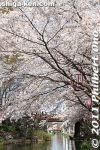
Hachiman-bori's highest concentration of cherry blossoms is near Hakuunbashi Bridge.
|
|
|
|
|
|
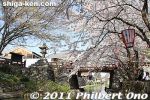
This bridge leads to Himure Hachimangu Shrine (to the left). This is the heart of Hachiman-bori moat.
|
|
|
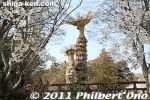
Near Hakuunbashi Bridge, you can see two of the giant torches to be lit for the Hachiman Matsuri fire festval later in the evening.
|
|
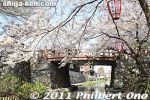
Being the heart of Hachiman-bori, Hakuunbashi Bridge is where the sakura is concentrated the most. 白雲橋
|
|
|

Hakuunbashi Bridge and stone lantern. 白雲橋
|
|
|
|
|

View from Hakuunbashi Bridge. 白雲橋
|
|
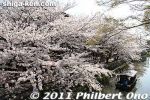
View from Hakuunbashi Bridge. 白雲橋
|
|

Beyond Hakuunbashi Bridge, the moat goes to Kawara Roof Tile Museum and the moat boat dock. The cherry trees also stop, but there a few more on the far end of the most.
|
|
|
|
|
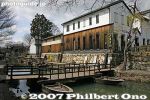
Unique, but controversial, bridge supported by two boats underneath.
|
|
|
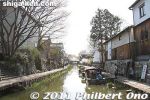
Near the Kawara Roof Tile Museum is this dock where you board the moat boat. Fare is 1,000 yen for adults.
|
|

Kawara Roof Tile Museum
|
|
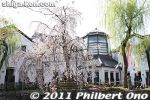
Kawara Roof Tile Museum in spring.
|
|
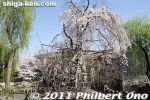
Kawara Roof Tile Museum's weeping cherry tree.
|
|
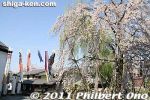
Kawara Roof Tile Museum's koinobori carp streamers and weeping cherry tree.
|
|
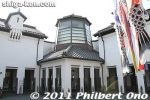
Kawara Roof Tile Museum
|
|
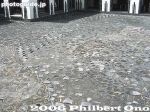
Kawara Roof Tile Museum's ground is covered with roof tiles, looking like cobblestones.
|
|
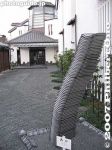
Outdoor sculpture at Kawara Roof Tile Museum, Omi-Hachiman, Shiga
|
|
|
|

Formerly a primary school built in 1877, Haku'unkan is now a tourist info office, souvenir shop, and exhibition space (2nd floor). 白雲館
|
|
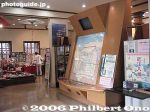
Inside 1st floor of Haku'unkan. The building was beautifully restored in 1994.
|
|

2nd floor exhibition space of Haku'unkan.
|
|

Omi-Hachiman's manhole depicts Hachiman-bori moat adorned with cherry blossoms. Shiga Prefecture.
|
|
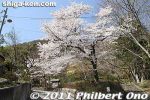
Another sakura spot is Hachiman Park next to Omi-Hachiman Pubic Library on the west end of the moat. 八幡公園
|
|
|
|
|
|
|
|
|
|
|
|
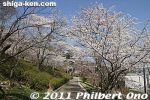
Hachiman Park cherry blossoms.
|
|
|
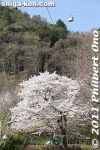
Hachiman Park is at the foot of Mt. Hachiman-yama.
|
|
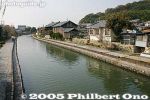
Hachiman-bori goes all the way to Lake Biwa. This is toward the west end of the moat.
|
|
|
|

Moat as seen from Ninomaru-Sawaguchi Tamon Yagura Turret. Iroha pine trees on left.
|
|

Moat as seen from Ninomaru-Sawaguchi Tamon Yagura Turret in spring.
|
|

Koedo Hikone NPO started operating "yakata-bune" Japanese-style boats in the moats of Hikone Castle as a tourist attraction for the castle's 400th anniversary in 2007. They operate 6 rides per day around the castle, taking 50 min.Boat landing for the Hikone-jo Ohori Meguri boat ride. Near the entrance to Genkyu-en Garden. They operate "yakata-bune" Japanese-style boats as a tourist attraction.
|
|

Hikone Castle Moat Boat Ride Poster
|
|

Inside Japanese-style yakata-bune boat. Seats 11 people on tatami mats. The roof is very low. 彦根城お堀めぐり
|
|

It certainly gives you a different perspective of the castle as you see the moat, castle tower, and bridges from the water. The ride costs 1,200 yen.
|
|

Heading toward Otemon Gate/Bridge
|
|
|

Otemon Bridge
|
|

Going under Otemon Bridge. Wooden boards protect the bridge posts from the boat.
|
|

The boat is powered by very silent, battery-powered outboard motors.
|
|

Otemon Bridge
|
|
|
|

A few of the stones in the wall are black. Some say those stones might have come from Azuchi Castle after it was burned to the ground.
|
|

The next Otemon Bridge
|
|
|
|
|
|

Castle tower as seen from the moat
|
|

Castle tower
|
|

The boat includes a narrator who explains about the castle and moat and swans.
|
|
|

End of the moat. The moat once was connected to Lake Biwa, but not anymore since the lake's water level does not match the moat's water level.
|
|

End of the moat. Lake Biwa is right beyond. This is where we make a U-turn.
|
|

Black swan in Hikone Castle's moat, a gift from Mito in Ibraraki Prefecture.
|
|

Ready to pass under Otemon Bridge again.
|
|
|

Boat landing is near the entrance to Genkyu-en Garden.
|
|
|
|

The second yakata-bune boat. They referred to old drawings, etc., and carefully built the boat to resemble Edo-Era yakata-bune.
|
|

End of the 50-min. ride. It was pleasant, and highly recommended. Boat landing for the Hikone-jo Ohori Meguri boat ride is near the entrance to Genkyu-en Garden.
|
|
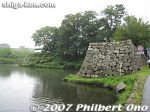
Hikone Castle moat on the way to Shiga University.
|
|
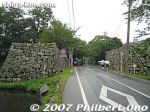
Shiga University is alongside the moat of Hikone Castle.
|
|
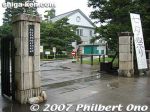
Entrance to Shiga University, Hikone Campus. It is a national university. (Not to be confused with University of Shiga Prefecture operated by the prefecture.)
|
|

The Faculties of Economics and Education are here in Hikone. The other campus is in Otsu. Map of the Hikone Campus.
|
|

Assembly Hall, a stately building.
|
|
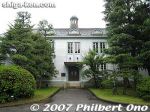
Assembly Hall
|
|
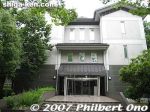
Archives Museum (経済学部附属史料館) at Shiga University.
|
|
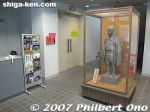
Shiga University's Archives Museum centers mainly on Omi shonin merchants.
|
|
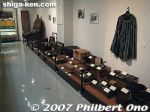
A good collection of artifacts related to Omi shonin.
|
|
|
|
|
|
|
|
|
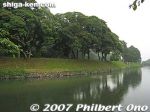
Hikone Castle moat
|
|
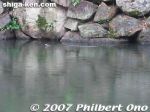
Snake swimming in the moat.
|
|

In Japanese, the Imperial Palace is called "Kokyo" (皇居). This term begun to be used from 1948. Until then, it was called "Kyujo" (meaning palace castle 宮城)from the time Emperor Meiji took up residence.
|
|

Nijubashi Bridge, the symbol of the Imperial Palace and Tokyo. One of Japan's most famous bridges. There is another bridge behind this one. 二重橋
|
|
|
|
|
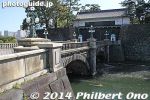
Rear of Nijubashi Bridge.
|
|
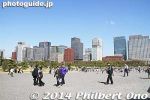
View of Marunouchi office buildings from Imperial Palace.
|
|

View from Nijubashi Bridge. The public can cross the bridge on the Emperor's Birthday (Dec. 23) and Jan. 2 for New Year's.
|
|

Crossing Nijubashi Bridge to enter the Seimon Gate. 正門
|
|

Fushimi Turret as seen from Nijubashi Bridge. Edo Castle was first built by Ota Dokan (太田道灌) in 1457 when Tokyo/Edo was still a small fishing village. Ota Dokan is thus regarded as one of Tokyo's forefathers. 伏見櫓
|
|
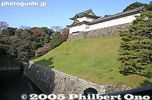
Fushimi Turret. This is what you see when you see Nijubashi Bridge. No one lives in this building. The Emperor's actual residence is not visible from the outside. 伏見櫓
|
|

Moat
|
|

Moat
|
|
|
|
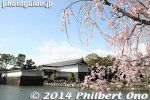
Weeping cherry blossoms near Otemon gate.
|
|
|
|
|
|

Tatsumi Turret 翼櫓(桜田二重櫓)
|
|

Tatsumi Turret 翼櫓(桜田二重櫓)
|
|
|

Tatsumi Turret, also called Sakurada-Niju Turret 翼櫓(桜田二重櫓)
|
|
|

Tatsumi Turret was used for defense with holes to drop stones and windows to shoot arrows. 翼櫓(桜田二重櫓)
|
|
|
|
|

桔梗門
|
|
|
|

Moat near Sakashita-mon Gate
|
|
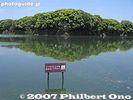
Corner of moat
|
|
|
|
|
|

Chidorigafuchi cherry blossoms are also lit up at night.
|
|

Chidorigafuchi lit up at night.
|
|

Horrendous line of people from Kudanshita Station inching their way to the cherry blossoms.Tip: You don't need to stand in this line. Just walk on the right toward the blossoms and keep walking on the side street parallel to the blossoms. You will soon find a way to enter the park.
|
|

Long line to enter the cherry blossom path...I did not stand in this line.
|
|

I slipped in and joined the crowd.
|
|

The crowd admire the night blossoms called yo-zakura.
|
|

Cherry blossoms are beautifully lit up at night in Chidorigafuchi.
|
|

People stream below a tunnel of cherry blossoms at night.
|
|

Blossoms and boat at night
|
|

The park includes a culture center, public library, sports ground, and the Kaitaku Kinenkan museum.
|
|

The best part of Kyuka Park is in the Ninomaru area.
|
|

Noted for cherry blossoms, Kyuka Park is on the site of Kuwana Castle which was occupied by Honda Tadakatsu.
|
|

Way to Honmaru, the central part of the castle.
|
|

Honmaru of Kuwana Castle. No castle buildings remain. Only moats and turret foundations. A shrine occupies much of the Honmaru area.
|
|

Kyuka Park cherry blossoms in Kuwana, Mie.
|
|
|
|
|
|
|

These blossoms were 1 or 2 days before reaching full bloom in early April.
|
|
|
|
|
|
|